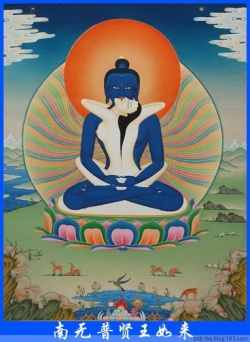Names of Adi-Buddha
Though all Buddhist figures are said to be emanations of the Adi-Buddha, certain Bodhisattvas are revered as its actual personality. This personality is often referred to as Dharmakaya, or "buddha-body of reality."
Samantabhadra/Samantabhadri
The Bodhisattva Samantabhadra, who, according to the Avatamsaka Sutra made ten great vows, is revered as Adi-Buddha in the Nyingma school of Vajrayana, along with his consort Samantabhadri. The two are usually depicted in union together in Tantric union. Samantabhadra is dark blue, while Samantabhadri is white. They appear together as Adi-Buddha in the Bardo Thodol (Tibetan Book of the Dead), at the center of the assembly of Peaceful Deities. Their wrathful forms are Mahotta Heruka and Krodheshvari.
There is some confusion over whether or not the Adi-Buddha Samantabhadra and the Bodhisattva Samantabhadra are in fact the same. Both appear as separate figures in the Bardo Thodol.
Vajradhara
Vajradhara (Dorje Chang) is regarded as Adi-Buddha in the Gelug and Kagyu schools. Vajradhara is also considered the Tantric form of Sakyamuni, the Great Sage of Humans. He also is depicted as dark blue in color. His esoteric doctrines were said to have been handed down to Marpa Lotsawa.
Vairocana
In Mahayana Buddhism, Vairocana is interpreted as the Bliss Body of Shakyamuni, and appears as such in the Avatamsaka Sutra. However, in the Vajrayana text the Mahavairocana Tantra, Vairocana is depicted as the Adi-Buddha. The Mahavariocana Tantra is the basis for Shingon Buddhism, the oldest esoteric school of Buddhist thought in Japan, where Vairocana is called Dainchi Nyorai (大日如來). Francis Xavier used the word "Dainchi" for the Christian God when he met with Shingon monks in the 16th Century. Upon learning that the word applied to Vairocana, Xavier dropped it.
Other Adi-Buddhas
Vajrasattva
Akshobhya
